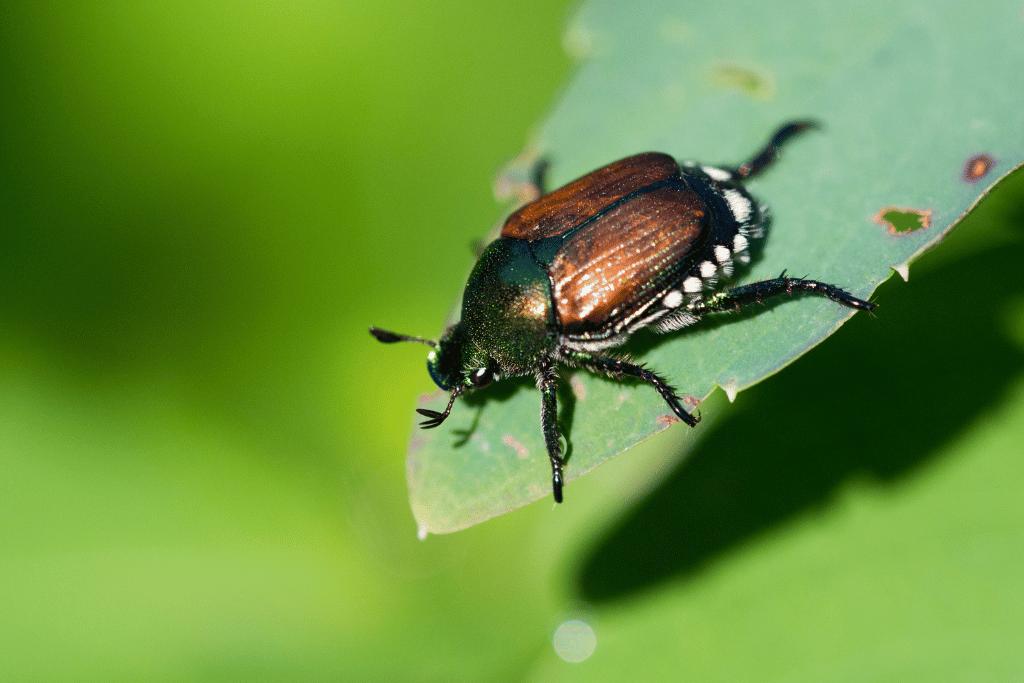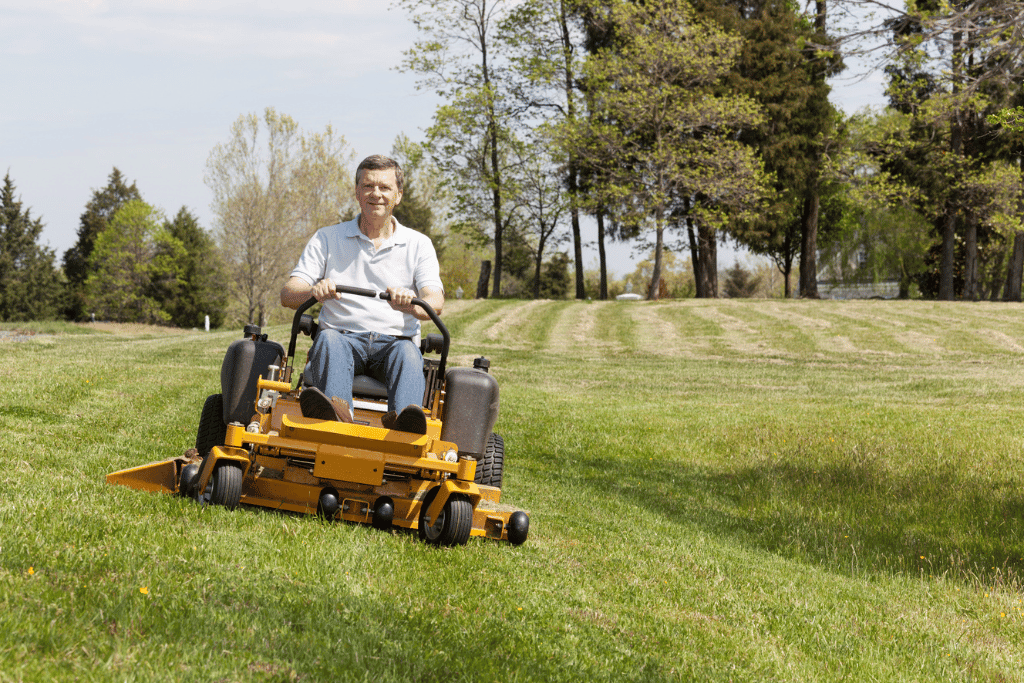
If this is your first time experiencing Japanese beetles, you might feel happy to see that it is nighttime and these insects have left your garden for good. However, things are not always what they seem.
These insects follow a typical 9-5 schedule and retract to their homes after sundown, only to return and enjoy the fruits of your gardening efforts the next day. Therefore, I will answer some of the most pertinent questions related to Japanese beetles in this article. Learning these things will help you better understand and tackle these invasive insects, and save your garden before it is too late.
Let us begin with the most important question: where do Japanese beetles go at night?
Where do Japanese Beetles go at Night?
Japanese beetles retreat to their nests when night approaches. They make these nests near thick foliage a few inches deep in the soil. Places with lots of plants or grass are their favorite resting spots.
Even though you might notice a few adult beetles scurrying around at night, these insects aren’t actively eating during this time. Their nests, which are tiny holes in the grass, are one of the indications that your garden may be suffering from a Japanese beetle infestation.
What Makes Japanese Beetles Dangerous?
To truly understand why Japanese beetles are so dangerous for a garden, we must learn more about these creatures. Learning things like how they look, their history, and how invasive they are will help you prepare for them and identify them better.
Overview of Japanese Beetles
Japanese beetles are scientifically known as Popillia japonica. They are a highly-invasive garden pest originating from Japan and other parts of Asia. Today, they’re found in many parts of the world, such as Europe, Canada, the United States, and regions of Africa.
These beetles hitched a ride to the US in 1916 on a cargo of iris bulbs from Japan. The legend is that its larvae attached to the plants and entered New Jersey. From there, it spread to other parts of the US, eventually concentrating in the eastern and midwestern US.
What Do Japanese Beetles Look Like?
An adult Japanese beetle is half an inch long with a metallic and shiny green body. The insect has two pairs of wings and six legs. The front pair of wings is hard with a coppery hue and protects the back pair, which is used for flying.
How Invasive are Japanese Beetles?
What makes Japanese beetles so dreaded in gardening and agriculture is their ability to consume 300+ types of plants. This includes fruits, vegetables, trees, ornamentals, and field crops. They are highly destructive and difficult to eradicate if allowed to reproduce for some time.

These insects are known for their increased appetites as they skeletonize plants by eating the flesh of the leaves while leaving the veins. They are also known to chew on the roots, making them especially dangerous for turf grass. If you notice patches of brown grass or leaves with their fleshy parts missing, you might have a Japanese beetle infestation. Apart from leaves or grass roots, this pest also feasts on soft fruit.
They have become a notorious agricultural pest in many parts of the US, especially the midwest. Japanese beetles in these regions damage beans, cherries, maize, grapes, and apple crops every year.
How Long Do Japanese Beetles Last?
Adult Japanese beetles last about 30-45 days. However, during winter months, it is harder for these insects to survive above ground. A female Japanese beetle lays its eggs underground during this time, and the larvae can go on living underneath(up to 3 years) to reappear next summer.
This means that even though the adult is short-lived, you should be exhaustive in your efforts to get rid of this pest. Even during its 40 days, the adult beetle can do extensive damage to last a year.
What is the Lifecycle of a Japanese Beetle?
Like most insects, the Japanese beetle has four growth stages. Learning about these phases and the insect’s particular characteristics during each phase will make identification easier for you. Let’s take a look at these stages.
Egg
The first phase begins when the female beetle creates an underground nest and lays 1-5 white, oval eggs. These eggs thrive in moist soil, and the female lays around 40 eggs throughout the season. After laying the eggs, the female returns to feeding.
Larva
The eggs gradually grow into grubs or larvae, which feed on the roots of your precious plants and turfgrass. These larvae go through five stages of development before turning into pupae. Larvae also tend to move around in the soil, looking for more food sources. This, in turn, deals more damage to the root system of your plants.

What makes larvae more dangerous than adults is their ability to overwinter. It means they can wait the winter out and appear above ground as adults when it is warmer outside.
Pupa
The pupae of Japanese beetles are cream or red-brown, and about half-inch wide. They are the phase between larvae and adulthood.
Adult Japanese Beetles
Adult Japanese beetles make their way above ground to start feeding. They also release pheromones to attract other beetles, reproduce, and lay eggs underneath the soil. This process continues until their death or as the weather turns cold.
At What Time do Japanese Beetles Come Out?
Japanese beetles are diurnal, meaning they are most active during daytime hours. This typically lasts from 8 am to 4 pm, after which they gradually retreat to their underground nests. During their waking hours, they engage in feeding and flying. For this reason, it is best to engage in pest-killing efforts in the morning.
Which Type of Weather do Japanese Beetles Prefer?
As you may have already understood, Japanese beetles prefer warm weather. They are most active when the temperature ranges between 80-85 F. Temperature is one of the reasons why these insects go to their nests at night.

Japanese beetles will appear when the weather changes from winter to summer and the temperature reaches 70 F. They also prefer humidity, but too much of it (60%+) can impede their flying. Higher humidity levels restrict them to a particular area where they feed to their heart’s pleasure.
As soon as the temperature drops below 70 F, their population dwindles. Gradually, the adults die off as the frost appears.
Do Japanese Beetles Die During the Winter?
When winter appears, the adult Japanese beetles die off while the larvae underground go into hibernation. As the temperature dips lower and lower, these larvae dig deeper into the ground. However, as soon as the cold spell is over, these larvae pupate, reach adulthood, and come out of their hiding places to feast on your beloved garden.
How to Get Rid of Japanese Beetles?
You can eliminate Japanese beetles using methods such as hand-picking, insecticides, repellant plants, or natural predators. You should also readjust your watering methods to make their survival more challenging.
For example, watering your plants at night will make the soil retain moisture longer. This type of humid environment is more conducive to Japanese beetles. Similarly, if you’re using pots, not having drainage holes or incorrect soil choice can also lead to more moisture.
Let us learn some of the most popular methods and my recommendations based on firsthand experience.
1. Hand-picking Japanese Beetles
This is a simple but time-taking method. However, it is also one of the most efficient in my experience. All you have to do is pick off the beetles you see in your garden and drop them in soapy water.
2. Japanese Beetle Traps
Beetle traps are touted as an effective method for beetle control. However, I have not found that to be the case. The trap has a particular scent that is supposed to attract the beetles.
In my experience, all beetles do is linger and feed around the trap without actually going inside.
3. Repellant Plants
Some most popular plants that can repel Japanese beetles are marigolds, rue, catnip, and tansy. These plants have a strong fragrance that Japanese beetles find unappealing.

On the other hand, you can also use geraniums. They are a special type of flower that can lure and paralyze Japanese beetles when they feed on them. This obviously means that you have to sacrifice some of these flowers, but the results are promising. Once paralyzed, you can simply pick them up and drop them in soapy water.
4. Natural Predators
To keep the infestation contained, you can also introduce natural predators such as parasitic nematodes or tachinid flies. This method is not effective on its own, but it can significantly help in combination with other methods.

Using milky spore fungus is another well-known technique. It is applied in powder form on turf grass or soil and helps eradicate the larvae population of Japanese beetles.
5. Dead Japanese Beetles
Another unique way to deal with Japanese beetles is to use their dead against them. The Japanese beetles are averse to the scent of other Japanese beetles. You can place these dead insects strategically to prevent alive beetles from feasting on your plants.
6. Insecticides and Pesticides
If you are experiencing a heavy infestation that doesn’t go away no matter what you do, it is time to bring out the big guns. You can find special-purpose insecticides designed for Japanese beetles. If you’re looking for an organic option, you can purchase or create a neem oil insecticide.
Final Words
Japanese beetles love routine. They eat during the day to peacefully go to sleep at night. There’s no doubt about how invasive and damaging they can be to your vegetation. The key to nipping this evil in the bud is to educate yourself about them, and this article will help you with that. Most importantly, the sooner you catch on these hungry pests, the better for you and your garden!



